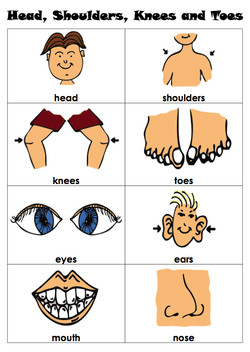 This song is a great way to teach body vocabulary and lots more with primary kids!
This song is a great way to teach body vocabulary and lots more with primary kids!
“Head, Shoulders, Knees, and Toes” is a beloved classic children’s song, instantly recognizable to generations. For many native English speakers, this song is a foundational part of early childhood, often learned at home or in preschool. While seemingly simple, this action song offers a wealth of educational opportunities, extending far beyond just naming body parts. For educators, especially those working with young learners or English Language Learners (ELLs), “Head, Shoulders, Knees, and Toes” is a powerful tool packed with potential for engaging lessons and skill development.
This seemingly basic song is far from simplistic in its pedagogical value. It provides a fantastic entry point for teaching body vocabulary, following directions, understanding sequencing, and even developing critical thinking skills. Let’s explore how to unlock the full educational potential of “Head, Shoulders, Knees, and Toes” in your classroom or home.
Mastering Body Parts Vocabulary
Before even singing a note, “Head, Shoulders, Knees, and Toes” offers a prime opportunity to introduce and reinforce body part vocabulary in English. It’s crucial not to assume prior knowledge, particularly with younger children or ELLs. Begin by explicitly teaching the vocabulary.
Start by saying the word and demonstrating the action. For instance, say “head” and touch your head. Then, ask students to mimic you, guiding them with clear instructions like, “Use your pointer finger to point to your head.” Emphasize the vocabulary by saying “head” clearly as you and the students point. Expand beyond just the song’s vocabulary. Introduce words like “tummy,” “ears,” “nose,” and “mouth” – body parts you might use in other songs or lessons throughout the year.
Use commands to reinforce understanding: “Point to your ears,” “Point to your nose.” Gradually simplify the commands from “Use your pointer finger to point to your…” to just “Point to your…” as students become more familiar. This direct instruction ensures everyone, especially ELLs, grasps the vocabulary before the added layer of singing.
Once you’ve worked through several body parts as a class, narrow your focus to the parts featured in the song: “head,” “shoulders,” “knees,” and “toes.” Practice pointing to each in isolation and then in sequence: “Point to your head. Point to your shoulders. Knees. Toes.” Turn it into a game. Call out body parts in a mixed order: “Point to your head. Your shoulders. Your toes. Your knees.” Then, challenge the students to do it independently, “I’m not going to point this time. Just you! Here we go. Head. Shoulders. Toes. Knees.” This active engagement solidifies their understanding and prepares them for the song itself.
 Download this visual for free!
Download this visual for free!
Sequencing and Pattern Recognition
“Head, Shoulders, Knees, and Toes” isn’t just about body parts; it’s inherently about sequence. The song follows a clear order, and learning this sequence is a valuable cognitive exercise for young children. The actions naturally flow from the top of the body downwards, reinforcing this sequential pattern.
After students are comfortable with the body parts and basic movements, highlight the sequence. Use sequencing words like “first,” “next,” “then,” “after that,” and “finally.” Ask questions like, “What body part comes first in the song? And then what’s next?” Encourage them to identify the pattern: “First, we touch our head, then our shoulders…”
Break down the song into phrases and discuss the patterns within each. The first phrase is a downward flow: “Head, shoulders, knees, and toes.” The second phrase repeats part of that pattern: “Knees and toes.” The third phrase shifts focus to the face: “Eyes and ears and mouth and nose.” And the final phrase returns to the downward flow: “Head, shoulders, knees, and toes.” Understanding these patterns aids memorization and develops pattern recognition skills, which are crucial for cognitive development.
Gradual Introduction of Melody and Rhythm
When introducing the song’s melody, proceed step-by-step. Start by singing the “Head, Shoulders, Knees, and Toes” pattern slowly, emphasizing the rhythm and melody. “Head, shoulders, knees, and toes, knees, and toes.” Ensure students are comfortable with the pattern of body parts and movements before adding the melody. Repetition is key, especially for ELLs who need time to process new sounds and patterns.
Resist the urge to rush ahead. As teachers, we might find this song overly simple, but for young learners, especially those new to English, it’s a multi-sensory learning experience involving new vocabulary, a new melody, and coordinated movements. Give them ample time to process and internalize each element.
Once the first part is comfortable, gradually introduce the next phrase, “Eyes and ears and mouth and nose.” Be mindful that this section introduces new vocabulary and a slightly higher melodic range. ELL students often feel more secure in mid-range melodies. Introduce this section gently, ensuring they are ready and comfortable before moving on.
Enhancing Memory and Focus: “What’s Missing?” Activity
To deepen engagement and enhance memory skills, incorporate the “What’s Missing?” activity. After students are confident singing the full song with actions, introduce a modified version.
Have students sit or stand and watch you demonstrate. Sing the song but replace one word, like “head,” with a hum. “HMMMMM, Shoulders, Knees and toes, knees and toes. HMMM shoulders, knees and toes, knees and toes…” Then, ask, “Was something different? What word did I leave out? Did I still do the action for ‘head’?”
This simple change transforms the song into a critical thinking exercise. Students must listen attentively, identify the missing word, and connect it to the action. After they identify the missing word, have them join in, humming in place of “head” as they sing and perform the actions for the rest of the song.
Gradually increase the challenge. Next, remove “shoulders,” then “knees,” and so on. Ask guiding questions: “Can you figure out what body part we would take out next?” This encourages them to think about the sequence and anticipate the pattern. Use sequencing words like “next,” “after that,” “then,” to further reinforce the concept.
For a final challenge, sing the entire song humming all the body parts, performing only the actions. This humorous and engaging variation reinforces their memory of the sequence and vocabulary. Conclude by singing the complete song with all the words, providing a sense of accomplishment and review.
Repetition and Reinforcement for Lasting Learning
Remember that repetition is crucial for young learners and especially beneficial for ELLs. Don’t treat “Head, Shoulders, Knees, and Toes” as a one-time lesson. Revisit the song in subsequent lessons and weeks to reinforce learning.
Each time you revisit the song, you can add a new layer or variation, like the “What’s Missing?” activity, or introduce musical accompaniment. This spaced repetition helps solidify vocabulary, sequence understanding, and musicality, ensuring lasting learning and mastery.
Beyond the Song: Extensions and Connections
The educational value of “Head, Shoulders, Knees, and Toes” extends beyond the song itself. Use it as a springboard for related activities and extensions.
- Visual Aids: Use flashcards or posters with body part names and images to support vocabulary learning.
- Movement Games: Create movement games related to body parts, like “Simon Says” using body part commands.
- Drawing and Labeling: Have students draw themselves and label the body parts they learned in the song.
- Storytelling: Encourage students to create simple stories incorporating body part vocabulary.
- Cross-Curricular Connections: Link the song to science lessons about the human body or health and wellness discussions.
By slowing down, being intentional, and incorporating varied activities, “Head, Shoulders, Knees, and Toes” transforms from a simple children’s song into a rich and multi-faceted learning experience. It’s a testament to how much educational value can be found even in the most familiar and seemingly basic resources, especially when approached with thoughtful pedagogy and a focus on engaging young minds.


